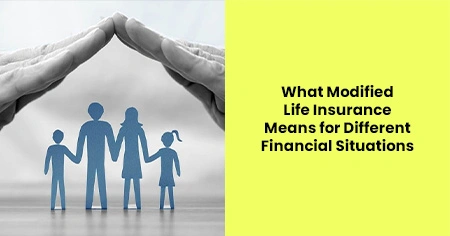To make an informed decision, it's crucial to understand how modified life insurance works, how it compares to other policies, and which life situations it best supports. From young professionals and new parents to those with health issues or inconsistent income, modified life policies offer a tailored approach to coverage, just not one-size-fits-all.
This guide explores the key features of modified life insurance and how it fits into diverse financial scenarios. Whether you're evaluating your first policy or considering a switch, knowing your options can help you align your insurance choices with your broader financial strategy.
Core Features of Modified Life Insurance
At its core, modified life insurance is a type of permanent life policy that includes a flexible premium structure. Rather than having a level premium from day one, the policy starts with lower premium payments for an initial period, often the first five to ten years, and then increases to a higher, fixed amount for the remainder of the policy’s life.
This structure appeals to people who expect their income or financial capacity to increase in the near future. Someone early in their career may find the initial affordability attractive while securing lifelong protection.
The policy includes a guaranteed death benefit and often builds cash value. The slower accumulation of cash value, during the initial low-premium years, is something to consider when comparing it to whole life or universal life options. Understanding how modified life works is important if you're thinking about committing to a policy with shifting financial requirements. It's not just about affordability in the short term, but planning for higher costs later while ensuring the benefits remain worth the investment.
When a Modified Policy Makes Sense for Budget-Conscious Families
One of the most common reasons people choose modified life insurance is to accommodate a tight or temporarily limited budget. Young families with new expenses such as childcare, mortgages, or student loans often prioritize affordability when selecting financial products.
A modified policy offers a chance to lock in life insurance coverage at a time when every dollar counts. The lower premiums in the early years can make it possible to maintain protection without sacrificing necessary living expenses. Then, as the family's income grows or debt load decreases, the budget may more comfortably support the increased premiums.
Families should be cautious. If future income doesn’t rise as expected, or if new expenses arise, the higher premiums later could become burdensome. Financial planning should include projections and contingency strategies to handle the shift in cost without losing coverage due to non-payment.
A Useful Tool for Career Starters and Recent Graduates
A recent college graduate may anticipate a promotion or career growth within a few years. With modified life insurance, they can take advantage of the lower initial premiums and then transition into higher payments when their financial situation stabilizes.
It’s a way to plan for the future while protecting their current financial position. It’s important to consider the opportunity cost. Early cash value growth is limited, and policyholders should evaluate whether a term policy with conversion options might be more appropriate depending on their future needs.
Managing Coverage with Irregular or Seasonal Income
Freelancers, seasonal workers, and gig economy professionals often face inconsistent income. Their ability to pay a traditional premium every month can fluctuate. Modified life insurance can provide a more manageable path to permanent coverage by aligning with their earning potential.
During months or years with lower earnings, the reduced premiums are easier to maintain. When income becomes more consistent or reaches a higher level, the policy's higher long-term premium takes effect. The critical factor here is discipline, policyholders must prepare for the shift in cost and plan accordingly.
Because of its rigid premium increase schedule, this policy does not allow for skipped payments or flexibility in the structure once initiated. If a major financial disruption occurs after the premium increases, it could lead to a lapse in coverage.
How It Compares to Other Permanent Policies
Modified life insurance is often compared to whole life and universal life, and each has distinct advantages depending on the policyholder's needs.
Whole life insurance offers fixed premiums, guaranteed cash value growth, and a stable death benefit. It’s predictable but can be cost-prohibitive in the early years.
Universal life insurance offers greater flexibility in premiums and death benefits, allowing policyholders to adjust contributions based on financial conditions. It requires more active management and is subject to interest rates and investment performance.
Modified life, by contrast, offers a hybrid of affordability and permanency. It lacks the early cash value strength of whole life and the flexibility of universal life, but wins on initial accessibility. It’s well-suited for people who expect future financial growth but want immediate, lasting coverage.
Limitations and Considerations Before Committing
Like any insurance product, modified life isn’t without its drawbacks. A common criticism is the back-loaded cost. When premiums rise after the introductory period, they may increase significantly, sometimes more than standard whole life policies would have cost from the beginning.
This structure reduces cash value accumulation early on. If building savings within your policy is a major goal, modified life may not be the best vehicle.
There’s the psychological impact of shifting payments. While the early affordability is attractive, the later costs can surprise policyholders who haven’t prepared. This can lead to policy cancellations, which means the time and money already invested could be lost without any benefits gained.
Prospective buyers should work closely with a financial advisor or insurance agent to run realistic scenarios for income growth, expense forecasting, and long-term value comparison.
Planning for Estate and Legacy Goals
For those who prioritize legacy planning or want to provide financial security for dependents or charities, modified life insurance can serve as a bridge toward more sophisticated estate planning tools. If income is limited early in life but expected to grow substantially, the policyholder can maintain lifetime coverage while eventually supplementing it with other investment strategies.
In estate planning, the guaranteed death benefit can be used to offset estate taxes, fund education for heirs, or provide capital to surviving family members. It may be paired with trusts or charitable giving programs.
Making the Right Choice Based on Life Stage
Modified life insurance is most beneficial when matched to the appropriate life stage. For younger individuals with financial limitations but long-term goals, it offers a gateway to permanent coverage. For those anticipating career changes or financial rebounds, it provides a time-sensitive advantage.
Older adults or those with chronic health issues may find that the long-term cost and limited early benefits don’t justify the policy. In such cases, a simplified issue whole life or guaranteed universal life may offer better value and coverage stability.
Modified life insurance offers a unique opportunity to blend affordability and permanency. It fits well into situations where income is expected to grow and immediate protection is important. Like all insurance products, its effectiveness depends on how well it aligns with your financial path, lifestyle, and goals.
How Health Conditions Influence Policy Eligibility
Modified life insurance can be a viable solution for individuals who might not qualify for traditional life insurance due to existing health conditions. Since some modified life policies involve simplified underwriting or fewer health-related questions, they may present an easier entry point for those with moderate medical risks.
This accessibility makes them attractive to individuals managing chronic conditions, recovering from major illnesses, or undergoing medical treatment that might otherwise result in policy denials. It’s important to read the fine print, as certain policies include a graded death benefit period, typically the first two to three years, where only partial benefits are paid out if the insured passes away.
While this limitation may seem like a drawback, it’s a calculated tradeoff. In exchange for easier approval, the policy imposes safeguards on the insurer’s end. For applicants who are honest and realistic about their life expectancy and financial goals, this arrangement can still provide peace of mind and crucial protection. Consulting with an agent who specializes in impaired-risk cases can help applicants determine whether a modified life policy is the best available option or if an alternative, such as guaranteed issue life insurance, may offer a better fit for their situation.
The Role of Modified Life in Blended Family Planning
Blended families often have unique financial planning challenges when it comes to ensuring that children from previous relationships, new spouses, and other dependents are all accounted for.
Modified life insurance can provide an affordable, long-term financial safeguard during the early years of blending households, when financial obligations such as new mortgages, childcare, and educational expenses may be higher. The policy’s lower initial premium allows for critical life coverage without straining the family budget during this transitional period.








